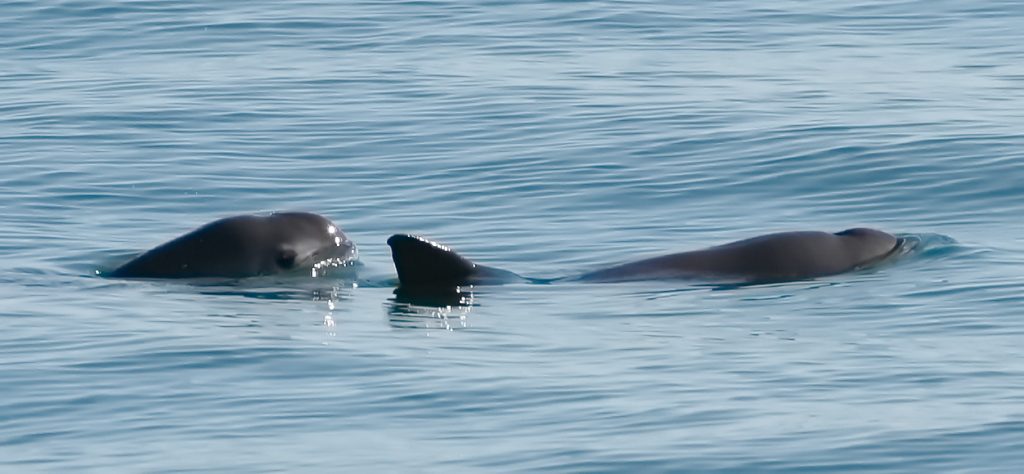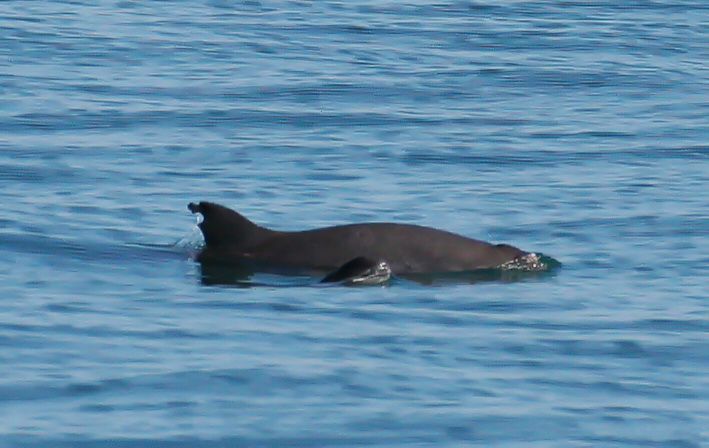Scientific Name
Phocoena sinus
Conservation Status (IUCN)
Critically Endangered (facing a very high risk of extinction in the wild)
Interesting Facts
The vaquita is the most endangered marine mammal in the world. First assessed as critically endangered in a 1996 IUCN report, the vaquita has become a symbol for environmental sustainability. In 2005, the Mexican Ministry of Environment declared a Vaquita Refuge that contains within its borders approximately 80% of all verified vaquita sighting positions in order to protect these critically endangered porpoises. This was followed by the declaration of a 2-year ban of gillnet fishing in the entire known vaquita range by Mexican president Enrique Peña Nieto in April 2015.
Range
Found only in the northern Gulf of California (Sea of Cortez), Mexico.
Physical Description and Identifying Features

Vaquita are identified by their tall, triangular, dark eye and beak tip, and dark grey/brown colour.
Behavior and Ecology
Usually found singly or in pairs, with occasional sightings of groups up to 10 animals. Inconspicuous and slow surfacing.
Reproduction
Sexually mature at 3-6 years. Gestation 11 months, with most calving from February to April.

Lifespan
21+ years
Diet
Small bottom-feeding fish and squid.
Conservation Concerns
With an estimated population of less than 100 individuals and ongoing decline due to entanglement in gillnets, vaquita are the most critically endangered porpoise species. Several studies implicate shrimp fishery bycatches to be responsible for the decline of the vaquita.
Illegal fishing with gillnets for another critically endangered species endemic to the Gulf of California, the totoaba (Totoaba macdonaldii), is also linked to the decline of the vaquita.
Learn more: Why is the vaquita endangered?
Conservation Action Timeline
- March 18, 1950:
A single skull is found along the shore of Punta San Felipe, in the northern Gulf of California, Mexico. A 1958 paper first describes “a new harbour porpoise of the genus Phocoena”. - 1978:
The International Union for Conservation of Nature (IUCN) places the vaquita on its red list with status “Vulnerable”. - January 9, 1985:
The US National Marine Fisheries Service (NMFS) adds the vaquita to the List of Endangered and Threatened Wildlife under the Endangered Species Act, effective February 8, 1985. - 1990:
The IUCN changes the conservation status to “Endangered”. - 1991:
Mexico signs and ratifies the Convention on International Trade in Endangered Species of Wild Fauna and Flora (CITES), which includes the vaquita and totoaba. - 1992:
Mexico bans gillnets used to capture totoabas. The fishery of this critically endangered species had already been banned in 1975. Mexico continues to allow fishing of totoaba for “research” from 1983 to 1993. - 1993:
The Mexican government creates a biosphere reserve of the Upper Gulf of California and Colorado River Delta. - 1996:
The IUCN once again re-assesses the vaquita’s conservation status. Based on abundance estimates it concludes that the species qualifies as “Critically Endangered”. - 1996/97:
The International Committee for the Recovery of the Vaquita (CIRVA) is created as an international task-force. It is tasked with the development of a recovery plan for the vaquita based on the best scientific evidence available, while also considering socio-economic aspects of conservation policies. In its first report, the committee identifies incidental by-catch as the main threat and concludes that the elimination of incidental fishery mortality should be the primary target of conservation efforts. - 2000:
New legislation in Mexico strengthens conservation efforts. The “Rules of the General Law of Ecological Equilibrium and Environmental Protection in matters of Natural Protected Areas” prohibit fisheries that result in by-catch of vaquita, totoaba, sea turtles or any other species at risk in the reserve. - 2005:
On CIRVA’s recommendation, the Mexican government decrees a refuge area for vaquita that encompasses about 80% of the area in which vaquita sightings have occurred. - 2008:
The recovery Plan for the Vaquita (PACE Vaquita) is published and recommends that compensation for fishers is needed. Options include a buyout under which fishers would surrender their boats and motors along with fishing gear; a switch-out that would provide fishers with alternative fishing gear; and a rent-out option under which fishers would stop using gillnets for one season. - April 29, 2015:
Mexican President Enrique Peña Nieto announces a program to conserve and protect the vaquita that includes a two-year ban on gillnet fishing in an area covering the entire known vaquita habitat. The plan includes the Mexican Navy’s assistance in enforcing the ban. - June 19, 2015:
A report is released by the Sub-Committee on Small Cetaceans at the International Whaling Commission that estimates a decline of the vaquita population of more than 40% in a single year, indicating that there might be as few as 50 individuals left. - December 2, 2015:
The 2015 Vaquita Survey (Expedición Internacional Vaquita Marina 2015) releases its End of Expedition Summary Report. It comes to the sobering conclusion that based on sightings and acoustic monitoring data, 7 out of 10 vaquitas have been lost since the last survey in 2008. It would take 40 years at the vaquita’s maximum population growth rate to reach 2008 levels. - May 13, 2016:
CIRVA releases a new population estimate for the vaquita: about 60 animals remain. - February 1, 2017:
CIRVA releases the CIRVA-8 report with devastating news for the vaquita: The population has continued to decline to now just 30 individuals (as of November 2016). Between 2011 and 2016 alone, 90% of the population (as determined estimated in 2011) has disappeared.
Video
Watch a presentation by Porpoise Conservation Society president Dr. Anna Hall on the vaquita and conservation efforts in Mexico.
Further Reading and References
[zotpress items=”I8W83422,HE4EMEGU,TCCE3IVE” style=”apa”]